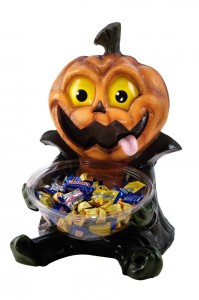 While most people think of trick or treating as a yearly tradition, and a chance for children to dress up in costumes and get free “treats” by going door to door, the actual beginnings of the ritual of trick or treating goes back centuries and was developed piecemeal into the holiday activity we now recognize here in North America and a few other countries.
While most people think of trick or treating as a yearly tradition, and a chance for children to dress up in costumes and get free “treats” by going door to door, the actual beginnings of the ritual of trick or treating goes back centuries and was developed piecemeal into the holiday activity we now recognize here in North America and a few other countries.
Let’s take a look at the early beginnings of this holiday tradition, move through the history of trick or treating, and explore how it developed into the fun activity it is today, where people actually hand out Halloween treats for kids on the last night of October.
The History Of Dressing Up
The origins of trick or treating actually had its beginning in dressing up and can be linked back to the ancient Celts and superstition.
The Celts believed that as they moved from one year to the next, the living and dead would overlap, and for a short period of time, demons would again walk the earth.
During this time, the Celts would build bonfires and pray.
In addition, those fearing they might draw the attention of demons would dress up as demons themselves, in order to “trick” these demons into believing they were one of them.
As Christianity began to spread, and the Church began converting people, they needed a way to pry people away from these old superstitious beliefs and customs, and so began All Hallows Eve and All Saints Day.
In place of all the Demon costumes, the Church urged people to dress up as Saints and Angels (while a few demons did linger) to celebrate All Saints Day on November 2nd.
As this custom became entrenched, the poor people and children of the community would dress up on the day before All Saints Day and go door to door begging for food or money, in exchange for promising to say prays on All Saints Day for the dead of the households they visited.
In some places, instead of prayers, homeowners would get treated to a song or a poem.
This practice was known as “souling”.
And this activity was the first roots of the “treating part of trick or treating”, though the actual term would come much later.
Halloween And Trick Or Treating Comes To North America
As people began to settle on the continent of North America, areas of the United States and Canada became a melting pot of many different diverse cultures and traditions.
Eventually, the old traditions of “souling” began in these new countries, but with so many diverse people living in different areas, the custom of “souling” began to change into what we now know today as Trick or Treating.
Strangely enough, the term “Trick or Treat” first appeared in the late 1920s and seemed to be a somewhat isolated incident, and during the 1920s and 1930s, seemed to be made up of a lot more tricking than treating, as masses of children would use Halloween as an opportunity to play tricks on homeowners.
During the Great Depression ,Trick or Treating became a real problem, when the damages people in larger cities suffered from these tricks mounted into thousands of dollars worth of damage.
Homeowners would often offer these children “treats” in exchange for leaving their homes and their property unscathed.
World War II Interrupts Trick Or Treating
When World Was II hit, it looked as though it would bring about the end of Trick or Treating.
Not only did people around the world have more important things to worry about than dressing up and going door to door to receives treats and play tricks, but the sugar rations made it impossible for people to offer tricksters those tasty bribes to prevent tricks from being played.
The children seemed to understand foregoing the holiday tradition they had begun.
Candy Companies Lead The Resurgence Of Trick Or Treating
After the end of WWII, there was a surge in the economy, and people began working more and getting paid more for the work they did.
Businesses thrived and new businesses were started.
Candy companies, looking for a way to get more of the financial pie, began targeting Halloween as a great time to buy those sweet candy treats.
In doing so, the candy companies not only led to the resurgence of “trick or treating”, but they helped to make Halloween the second most lucrative holiday from a business standpoint.
By the 1950s, trick or treating was here to stay.
Small Changes In Trick Or Treating Over The Last Few Decades
After the resurgence of trick or treating began, the trick portion of this holiday began to become less intense, with law enforcement agencies viewing the property damage of the past as a punishable offense, so children began playing less damaging tricks.
Today, few tricks are actually played.
Treats have undergone some changes.
Fears of people sabotaging homemade treats with poisons and other things led to doing away with homemade treats and the giving of candy, and in a few cases, pennies, nickles, and quarters were used in place of candy.
In more recent years, the growing obesity problems among children has caused many people to rethink the type of treats they want to give the children who come to their door.
This has resulted in many people searching for healthier alternatives to those traditional candy treats.
Today, many trick or treat bags contain small non edible treats, such as colorful pencils, book marks, balls, stickers, Halloween rings, and many other fun surprises.
No doubt Trick or Treating will continue to change as time goes by, but it looks like this holiday tradition is here to stay.
Enjoyed this article? Share it with others








 Facebook
Facebook Pinterest
Pinterest Twitter
Twitter Google+
Google+